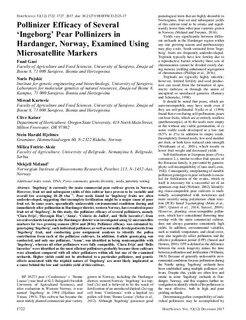Pollinizer efficacy of several ‘Ingeborg’ pear pollinizers in Hardanger, Norway, examined using microsatellite markers
| dc.contributor.author | Gasi, Fuad | |
| dc.contributor.author | Pojskic, Naris | |
| dc.contributor.author | Kurtovic, Mirsad | |
| dc.contributor.author | Kaiser, Clive | |
| dc.contributor.author | Hjeltnes, Stein Harald | |
| dc.contributor.author | Fotiric-Aksic, Milica | |
| dc.contributor.author | Meland, Mekjell | |
| dc.date.accessioned | 2018-03-13T14:23:12Z | |
| dc.date.available | 2018-03-13T14:23:12Z | |
| dc.date.created | 2018-01-07T20:52:01Z | |
| dc.date.issued | 2017-12 | |
| dc.identifier.citation | Hortscience. 2017, 52 (12), 1722-1727. | nb_NO |
| dc.identifier.issn | 0018-5345 | |
| dc.identifier.uri | http://hdl.handle.net/11250/2490346 | |
| dc.description.abstract | ‘Ingeborg’ is currently the main commercial pear cultivar grown in Norway. However, fruit set and subsequent yields of this cultivar have proven to be variable and overall low averaging 10–20 t·ha−1. Pear seeds found in ‘Ingeborg’ fruits are often underdeveloped, suggesting that incomplete fertilization might be a major cause of poor fruit set. In some years, sporadically unfavorable environmental conditions during and immediately after pollination in Hardanger district, western Norway, have resulted in poor fruit set of ‘Ingeborg’. In this study, the pollinizer efficacy of several pollinizers, namely ‘Clara Frijs’, ‘Herzogin Elsa’, ‘Anna’, ‘Colorée de Juillet’, and ‘Belle lucrative’, from several orchards located in the Hardanger district was investigated using 12 microsatellite markers for two growing seasons (2014 and 2016). Pollinizer efficacy was estimated by genotyping ‘Ingeborg’, each individual pollinizer, as well as normally developed seeds from ‘Ingeborg’ fruit, and conducting gene assignment analyses to identify the pollen contribution from each of the pollinizer cultivars. In addition, S-allele genotyping was conducted, and only one pollinizer, ‘Anna’, was identified as being semicompatible with ‘Ingeborg’, whereas all other pollinizers were fully compatible. ‘Clara Frijs’ and ‘Belle lucrative’ were identified as the most efficient pollinizers probably because these cultivars were abundant compared with all other pollinizers within all, but one of the examined orchards. Higher yields could not be attributed to a particular pollinizer, and genetic effects associated with the triploid nature of ‘Ingeborg’ are most likely implicated as a cause behind the low and variable yield of this cultivar. | nb_NO |
| dc.language.iso | eng | nb_NO |
| dc.publisher | American Society for Horticultural Science | nb_NO |
| dc.rights | Attribution-NonCommercial-NoDerivatives 4.0 Internasjonal | * |
| dc.rights.uri | http://creativecommons.org/licenses/by-nc-nd/4.0/deed.no | * |
| dc.subject | DNA | nb_NO |
| dc.subject | Pyrus communis | nb_NO |
| dc.subject | genetic diversity | nb_NO |
| dc.subject | seeds | nb_NO |
| dc.subject | paternity testing | nb_NO |
| dc.title | Pollinizer efficacy of several ‘Ingeborg’ pear pollinizers in Hardanger, Norway, examined using microsatellite markers | nb_NO |
| dc.type | Journal article | nb_NO |
| dc.type | Peer reviewed | nb_NO |
| dc.description.version | publishedVersion | nb_NO |
| dc.rights.holder | This is an open access article distributed under the CC BY-NC-ND license (http://creativecommons. org/licenses/by-nc-nd/4.0/). | nb_NO |
| dc.source.pagenumber | 1722-1727 | nb_NO |
| dc.source.volume | 52 | nb_NO |
| dc.source.journal | Hortscience | nb_NO |
| dc.source.issue | 12 | nb_NO |
| dc.identifier.doi | 10.21273/HORTSCI12323-17 | |
| dc.identifier.cristin | 1537226 | |
| dc.relation.project | Norges forskningsråd: 244510 | nb_NO |
| cristin.ispublished | true | |
| cristin.fulltext | original | |
| cristin.qualitycode | 1 |
Tilhørende fil(er)
Denne innførselen finnes i følgende samling(er)
-
Publikasjoner fra CRIStin - NIBIO [4576]
-
Vitenskapelige artikler [1416]

